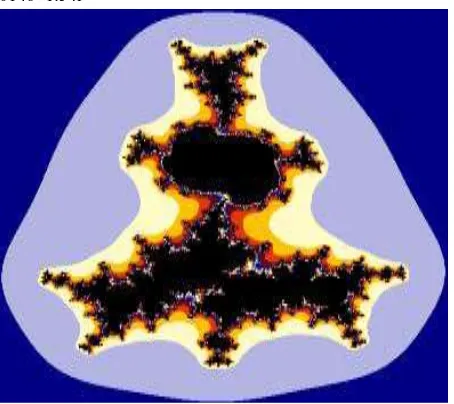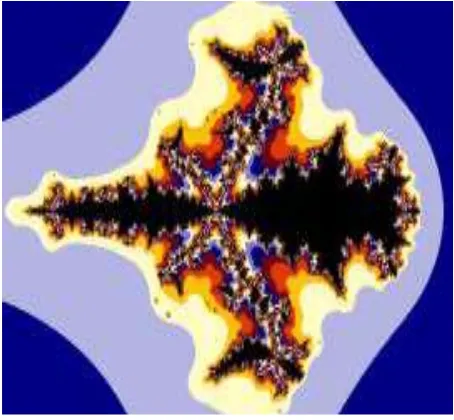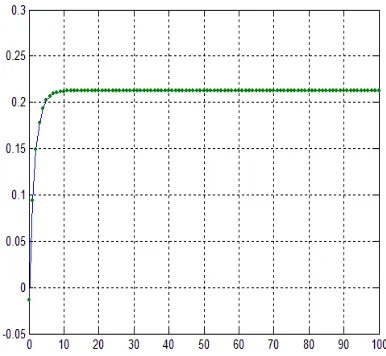A Relative Superior Julia Set and Relative Superior
Tricorn and Multicorns of Fractals
Priti Dimri
HeadDept. of Computer Science and Engineering
G.B.Pant Engineering College Ghurdauri, Pauri
Shashank Lingwal
Dept. of Computer Science andEngineering
G.B.Pant Engineering College Ghurdauri, Pauri
Ashish Negi
Associate Professor Dept. of Computer Science andEngineering
G.B.Pant Engineering College Ghurdauri, Pauri
ABSTRACT
In this paper we investigate the new Julia set and a new Tricorn and Multicorns of fractals. The beautiful and useful fractal images are generated using Ishikawa iteration to study many of their properties. The paper mainly emphasizes on reviewing the detailed study and generation of Relative Superior Tricorn and Multicorns along with Relative Superior Julia Set.
Keywords
Complex dynamics, relative superior Julia set, Ishikawa iteration, Relative superior Tricorn, Relative superior Multicorns.
1.
INTRODUCTION
The term „Fractal‟ was coined by Benoit B Mandelbrot, in 1975 to denote his generalisation of complex shapes. Fractal is derived from Latin word „fractus‟ which describes the appearance of broken stone : irregular and fragmented. The object Mandelbrot set, given by Mandelbrot 1979 and its relative object Julia set due to their beauty and complexity of their nature have become elite area of research nowadays. The fractal graphics are generally obtained by “colouring” the escape speed of the seed points within the certain regions of complex plane that give rise to the unbounded orbits.
Many authors have presented the papers on several “orbit traps” rendering methods to create the artistic fractal images. An orbit trap is a bounded area in complex plane into which an orbiting point may fall. Motivated by this idea of “orbit traps”, Chauhan [4] introduces the different type of orbit traps for Ishikawa iteration procedure. They have considered Julia sets of
z
n1
az
n2
c
, as orbit traps to explore their relevant fractal images, since, it is connected and bounded for a and c.Recently Shizuo [15] has quoted the Multicorns as the generalized Tricorns or the Tricorns of higher order and presented various properties of them. Tricorn are being used for commercial purpose, e.g. Tricorn Mugs and Tricorn T shirts. Multicorns are symmetrical objects. Their symmetry has been studied by Lau and Schleicher [11]. Negi [16] have introduced a new class of Relative Superior Multicorns using Ishikawa iterates and also studied their corresponding Relative Superior Julia sets.
2.
ELABORATION OF CONCEPT
INVOLVED
2.1
Mandelbrot Set
Definition 1. [17] The Mandelbrot set M for the quadratic 2
( ) = z + c
C
Q z is defined as the collection of all cC for which the orbit of point 0 is bounded, that is, { :{ n(0)}; 0,1, 2, 3... is bounded}
c
M cC Q n
An equivalent formulation is
{ :{ n(0) does not tends to as }}
c
M cC Q n
We choose the initial point 0, as 0 is the only critical point of Qc.
2.2
Julia Set
Definition 2. [17] The set of points K whose orbits are bounded under the iteration function of Qc(z) is called the
Julia set. We choose the initial point 0, as 0 is the only critical point of Qc(z) .
2.3
Tricorn and Multicorns
Please The study of connectedness locus for antiholomorphic polynomials z2c defined as Tricorn, coined by Milnor [14], plays intermediate role between quadratic and cubic polynomials.
Definition 3. [5] The Multicorns Ac , for the quadratic
( ) 'n
c
A z z cis defined as the collection of all cC for which the orbit of the point 0 is bounded, that is,
0,1,2,3...
{ : (0) is bounded}
c c n
A cC A . An
equivalent formulation is
{ : (0) not tends to as }
c c
A cC A n .
The Tricorn are special Multicorns when n=2. As quoted by Devany [7][8], iteration of function 2
'
c
A z c, using the Escape Time Algorithm, results in many strange and surprising structures. Devany [7][8] has named it Tricorns and observed that f(z‟), the conjugate function of f(z), is antipolynomial. Further, its second iterates is a polynomial of degree 4. The function z'2cis conjugate of 2
' z d, where 2 i/3
d e , which shows that the Tricorn is
symmetric under rotations through angle 2 / 3. The critical point for Ac is 0, since c Ac(0)has only one preimage
2.4
Picard’s Orbit
Definition 4. Let X be a nonempty set and f :X X . For any point
0
x X , the Picard‟s orbit is defined as the set of iterates of a point
x
0, that is;1
( , ) { n; n ( n ), 1, 2, 3...}
O f x x x f x n .
In functional dynamics, we have existence of two different types of points. Points that leave the interval after a finite number are in stable set of infinity. Points that never leave the interval after any number of iterations have bounded orbits. So, an orbit is bounded if there exists a positive real number, such that the modulus of every point in the orbit is less than this number. The collection of points that are bounded, i.e. there exists M, such that n( )
Q z M , for all n, is called as a prisoner set while the collection of points that are in the stable set of infinity is called the escape set. Hence the boundary of a prisoner set is simultaneously the boundary of escape set and that is Julia set for Q.
2.5
Ishikawa Iteration
Definition 5. Ishikawa Iterates[17]: Let X be a subset of real or complex number and f :X X for all
0
x X , we have the sequence {xn} and {yn} in X in the following
manner:
' ( ) (1 ' )
n n n n n
y S f x S x
1 ( ) (1 )
n n n n n
x S f y S x
where 0S'n 1, 0Sn 1 and S'n & Sn are both
convergent to non-zero number.
2.6
Relative Superior Mandelbrot Set
Now we define Mandelbrot set for the function with respect to Ishikawa iterates. We call them as Relative Superior Mandelbrot sets.Definition 6. [17] Relative Superior Mandelbrot set RSM for the function of the form ( ) n
c
Q z z c, where n = 1,2,3,… is defined as the collection of cC for which the
orbit of 0 is bounded i.e.
{ : k(0) : 0,1, 2, 3...}
c
RSM cC Q k is bounded.
In functional dynamics, we have existence of two different types of points. Points that leave the interval after a finite number are in stable set of infinity. Points that never leave the interval after any number of iterations have bounded orbits. So, an orbit is bounded if there exist a positive real number.
2.7
Relative Superior Julia Set
Definition 7. [17] The set of points RSK whose orbits are bounded under relative superior iteration of function Q(z) is called Relative Superior Julia sets. Relative Superior Julia set of Q is boundary of Julia set RSK.
3.
GENERATING PROCESS
The basic principle of generating fractals employs the iterative formula:
1 ( )
n n
z f z where z0 = the initial valueof z,
and zi = the value of complex quantity z at the ith iteration
[17]. For example, the Mandelbrot‟s self-squared function for generating fractal is: f(z) = z2+c , where z and c are both complex quantities. We propose the use of transformation
function n , 2
zz c n and 1
( n )
z z c for generating fractal images with respect to Ishikawa iterates, where z and c are the complex quantities and n is a real number. Each of these fractal images is constructed as two-dimensional array of pixel. Each pixel is represented by a pair of (x,y) coordinates. The complex quantities z and c can be represented as:
x y
zz iz
x y
cc ic
where i ( 1) and zx , cx are the real parts and zy , cy are
the imaginary parts of z and c respectively. The pixel coordinates (x,y) may be associated with (cx,cy) or (zx,zy) .
Based on this concept, the fractal images can be classified as follows:
(a) z-Plane fractals, wherein (x,y) is a function of (zx,zy).
(b) c-Plane fractals, wherein (x,y) is a function of (cx,cy).
In the literature, the fractals for n=2 in z plane are termed as the Mandelbrot set while the fractals for n=2 in c plane are known as Julia sets [4, 5]
4.
ESCAPE CRITERIA FOR RELATIVE
SUPERIOR MANDELBROT AND JULIA
SET
4.1
Escape Criterion for Quadratics
[13] Suppose that z max{c, 2 / , 2 / '}s s , then
(1 )n
n
z z and z as
n
. So, z c and z 2 /s as well as z 2 /s' shows the escape criteria for quadratics.4.2
Escape Criterion for Cubics
[13] Suppose 1/ 2 1/ 2
max{ , ( 2 / ) , ( 2 / ') }
z b a s a s
then
n
z as
n
. This gives the escape criterion for cubic polynomials.4.3
General Escape Criterion
[13]Consider z max{c, (2 / )s 1/ 2, (2 / ')s 1/ 2} then
n
z as
n
is the escape criterion.Note that the initial value z0 should be infinity, since infinity
is the critical point of 1
( n )
z z c . However, instead of starting with z0 = infinity, it is simpler to start with z1 = c,
which yields the same result. A critical point of ( )
5.
SIMULATION AND RESULTS
[image:3.595.310.550.70.246.2]Fixed point of quadratic polynomial- [4]
Table 1 : Orbit of F(Z) for (z0 = -1.71 -0.24i)
at s=0.3 and s‟ = 0.4
Number of
Iteration i |F(z)|
Number of
Iteration i |F(z)|
1 1.7268 13 0.97304
2 1.3866 14 0.97304
3 1.2095 15 0.97304
4 1.132 16 0.97304
5 1.0602 17 0.97304
6 1.0051 18 0.97304
7 0.98257 19 0.97304
8 0.97564 20 0.97304
9 0.97308 21 0.97304
10 0.9732 22 0.97304
11 0.97308 23 0.97304
[image:3.595.50.290.130.360.2]12 0.97305 24 0.97304
Fig. 1 : Observation : Here we observe that the value converges to a fixed point after 13 iterations
Fixed Point for Cubic Polynomial
Table 2 : Orbit of F(z) for (z0 = -0.08+0.057i)at s=0.8 and
s‟=0.2
Number of
Iteration i |F(z)|
Number of
Iteration i |F(z)|
10 0.26107 25 0.26713
11 0.27154 26 0.26716
12 0.26406 27 0.26721
13 0.26942 28 0.26717
14 0.26558 29 0.2672
15 0.26833 30 0.26718
16 0.26637 31 0.26719
17 0.26777 32 0.26718
18 0.26677 33 0.26719
19 0.26749 34 0.26719
20 0.26697 35 0.26719
21 0.26734 36 0.26719
22 0.26708 37 0.26719
23 0.26717 38 0.26719
24 0.26727 39 0.26719
Fig. 2 :Observation : We skipped 09 iteration and value converges to a fixed point after 33 iterations
[image:3.595.328.525.301.478.2]Fixed point for Bi-quadratic Polynomial
Table 3 : Orbit of F(z) for (z0=0.134+0.128i) at s=0.3 and
s‟=0.4
Number of
Iteration i |F(z)|
Number of
Iteration i |F(z)|
81 0.9200 96 0.9199
82 0.9196 97 0.9200
83 0.9197 98 0.9200
84 0.9201 99 0.9198
85 0.9201 100 0.9198
86 0.9198 101 0.9200
87 0.9197 102 0.9200
88 0.9200 103 0.9199
89 0.9201 104 0.9198
90 0.9199 105 0.9199
[image:3.595.69.263.413.597.2] [image:3.595.309.551.547.760.2]92 0.9199 107 0.9199
93 0.9200 108 0.9199
94 0.9199 109 0.9199
[image:4.595.316.543.71.270.2]95 0.9198 110 0.9199
Fig. 3: Observation : We skipped 81 iteration and after 107 iteration value converges to a fixed point
Generation of Relative Superior Julia Set
[image:4.595.69.263.187.374.2]Relative Superior Julia set for Quadratic
Fig. 4 : Relative superior Julia set for s=1, s‟=0.3, c= 0.430+0.18i
Fig. 5 : Relative Superior Julia Set for s=0.1, s‟=0.4, c=-20.26+0.097i
Relative Superior Julia set for Cubic function :
[image:4.595.316.543.324.526.2]Fig. 6 : Relative Superior Julia set for s=1, s‟=0.5, c= -0146+1.54i
Fig. 7 : Relative Superior Julia Set for s=0.1, s‟= 0.4, c=-1.6+6.7i
[image:4.595.54.280.464.672.2] [image:4.595.315.542.560.743.2]Fig. 8 : Relative Superior Julia set for s= 1, s‟= 0.5, c = -1.57
Fig. 9 : Relative Superior Julia Set for s=0.3, s‟=0.4, c=-3.6
Fixed Points For Quadratic Polynomial – [5]
Table 4 : Orbit of F(z) for s=0.6, s‟=0.4 at z0=0.06415024553+0.03414122547i
Number of
Iteration i |F(z)|
Number of
Iteration i |F(z)|
1 0.07267 14 0.23604
2 0.13743 15 0.23621
3 0.17641 16 0.23638
4 0.19914 17 0.23643
5 0.21289 18 0.23646
6 0.22143 19 0.23648
7 0.22681 20 0.23649
8 0.23025 21 0.2365
9 0.23246 22 0.2365
10 0.23389 23 0.23651
11 0.23481 24 0.23651
12 0.2354 25 0.23651
[image:5.595.326.524.178.369.2]13 0.23579 26 0.23651
Fig. 10 : The Value Converges to a fixed point after 23 iterations
Fixed Point for Cubic Polynomial
Table 5 : Orbit of F(z) for s=0.5, s‟ =0.4 at z0
=-0.01341912254 + 0.001017666092i
Number of
Iteration i |F(z)|
Number of
Iteration i |F(z)|
1 0.013458 12 0.21207
2 0.09368 13 0.2122
3 0.14876 14 0.21228
4 0.17784 15 0.21232
5 0.19348 16 0.21235
6 0.20199 17 0.21236
7 0.20665 18 0.21236
8 0.20922 19 0.21236
9 0.21063 20 0.21237
10 0.21141 21 0.21237
[image:5.595.53.280.312.522.2] [image:5.595.310.552.428.642.2]Fig. 11 : Here value converges to a fixed point after 20 iterations
[image:6.595.69.262.106.284.2]Fixed Points of Bi-Quadratic polynomial
Table 6 : Orbit of F(z) for s=0.8, s‟=0.2 at z0=
0.02786208647 – 0.03509673188i
Number of
Iteration i |F(z)|
Number of
Iteration i |F(z)|
1 0.044812 7 0.12663
2 0.10592 8 0.12664
3 0.12207 9 0.12664
4 0.12563 10 0.12664
5 0.12642 11 0.12664
[image:6.595.316.545.124.329.2]6 0.12659 12 0.12664
Fig. 12 : Here the value converges to a fixed point after 8 iterations
Generation of Relative Superior Tricorns and Multicorns
Relative Superior Tricorn for Quadratic function
[image:6.595.313.543.348.545.2]Fig. 13 : Relative superior Tricorn for s=s‟=1
Fig. 14 : Relative Superior Tricorn for s=0.6, s‟=0.4
[image:6.595.69.263.527.702.2]Relative Superior Multicorns for Cubic Function
[image:6.595.313.539.574.747.2]Fig. 16 : Relative Superior Multicorns for s=0.5, s‟=0.4
[image:7.595.314.545.116.309.2]Relative Superior Multicorns for Bi-quadratic function
[image:7.595.314.545.332.530.2]Fig. 17 : Relative Superior Multicorns for s=s‟=1
Fig. 18 : Relative Superior Multicorns for s=0.8, s‟=0.2
Generalization of Relative Superior Multicorns
Fig. 19 : Relative Superior Multicorns for s=0.1, s‟ = 0.3, n=19
Fig. 20 : Relative Superior Multicorns for s=0.1, s‟=0.3, n=52
6.
CONCLUSION
The geometry of Relative Superior Julia sets and Mandelbrot set are explored for Ishikawa iteration and corresponding fractal images are generated. Different types of orbit traps are generated for Ishikawa iteration procedure.
The study shows that these sets are exclusively elite and effectively different from other existing Mandelbrot sets. In dynamics of antipolonomial of complex polynomial z‟n
+c, where
n
2
, there exist many Tricorns and Multicorns antifractals for a value of n with respect to Relative Superior orbit. [image:7.595.54.282.340.548.2] [image:7.595.55.278.574.760.2]7.
ACKNOWLEDGMENTS
Our thanks to Dr. A.K Swami, Principal, G.BPant Engineering College, Ghurdauri, for providing necessary infrastructure for the research work. We would also like to thank Mr. Yashwant Singh Chauhan, Assistant Professor, Department of Computer Science and Engineering, G.B.Pant Engineering College, Ghurdauri, for his unconditional and valuable support in writing this paper.
8.
REFERENCES
[1] R.Abraham and C.Shaw, Dynamics : “The geometry of Behaviour, Part One: Periodic Behaviour, Part Two : Chaotic Behaviour” Aerial Press, Santa Cruz, Calif,(1982)
[2] Alan F.Beardon, “Iteration of Rational Functions”, Springer Verlag, N.York, Inc.(1991)
[3] B.Branner and J.Hubbard, “The iteration of Cubic Polynomials”. Part I, Acta. Math.66(1998), 143-206 [4] Yashwant S Chauhan, Rajeshri Rana and Ashish Negi,
“New Julia Sets of Ishikawa Iterates”, International Journal of Computer Applications (0975-8887), Volume 7 – No.13, October 2010
[5] Yashwant S Chauhan, Rajeshri Rana and Ashish Negi, “New Tricorn & Multicorns of Ishikawa Iterates”, International Journal of Computer Applications (0975-8887), Volume 7 – No.13, October 2010
[6] R.M.Crownover, “Introduction to Fractals Chaos, Mandelbrot sets”, Jones and Barlett Publishers, (1995) [7] R.L.Daveney, “An Introduction to Chaotic Dynamical
Systems ” Springer-Verlag, N.york. Inc.1994
[8] R.L.Daveney, “A First Course in Chaotic Dynamical System : Theory and Experiment” , Addison-Wesley, 1992. MR1202237
[9] S.Ishikawa, “Fixed points by a new iteration method”, Proc. Amer. Math. Soc.44(1974), 147-150
[10]Manish Kumar, and Mamta Rani, “A New Approach to Superior Julia Sets”, J.nature. Phys. Sci, 19(2), (2005), 148-155
[11]Eike Lau and Dierk Schleicher, “Symmetries of fractals revisited.”, Math. Intelligencer (18)(1)(1996), 45-51. MR1381579 Zbl 0847.30018.
[12]B.B.Mandelbrot, “The Fractal aspects of iteration ofzz(1z) for complex and z” Ann. N.Y.Acad. Sci. 357(1980), 249-259
[13]W.R.Mann, “Mean Value Methods in iteration”, Proc. Amer. Math. Soc.4 (1953), 506-510
[14]J.Milnor, “Dynamics in one complex variable; Introductory Lectures”, Vieweg(1999)
[15]Shizuo Nakane, and Dierk Schleicher, “Non-local connectivity of the Tricorn and multicorns”, Dynamical Systems and chaos (1)(Hachioji, 1994), 200-203, World Sci. Publ., River Edge, NJ, 1995 MR1479931.
[16]Ashish Negi, “Generation of Fractals and Applications”, Thesis, Gurukul Kangari Vishwvidyalaya, (2005) [17]Ashish Negi, Shashank Lingwal and Yashwant Singh
Chauhan, “Complex and Inverse Complex Dynamics of Fractals using Ishikawa Iteration”, International Journal of Computer Applications (0975-8887) Volume 40-No.12, February 2012
[18]M.Rani and V.kumar, “Superior Mandelbrot Set”, J Korea Soc. Math. Edu. Series, DResearch in Maths. Edu. No.4,8(2004), 279-291
[19]K.Shirriff, “Fractals from Simple Polynomial Composite Functions”, Computer and Graphics, 17(6), Nov. 1993, pp 701-703




